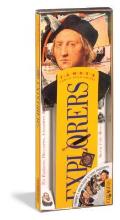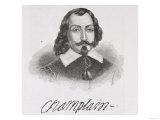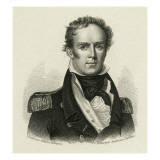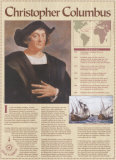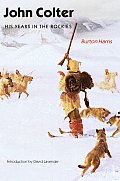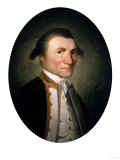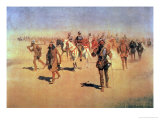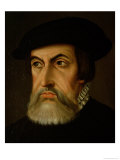|
|
|
|
|
Samuel de Champlain
b. 1567; Brouage, France
d. 12-25-1635; Quebec City
Samuel de Champlain, the “Father of New France,” and founder of Quebec City, opened North America to French colonization with the fur trade.
Champlain was born in a seaport town on France's west coast and naturally became a salior, progressing to navigator and mapmaker. He would spend several months or years exploring North America in the area of present day Quebec and the area of the US Lake Champlain (named for him in 1609) and then return to France to find investors for more exploration.
• see Jean Nicolet
|
|
|
|
|
|
|
|
|
|
John Colter
b. c 1774-5; Stuarts Draft, Augusta Co., Virginia
d. 1812-1813; Missouri (possibly New Haven)
Mountain man John Colter, one of the original members of the Lewis & Clark Expedition, is better remembered for the being the first known person of European descent to see the Teton Mountains and what is now known as Yellowstone National Park. His reports had unbelieving fellow trappers calling the place “Colter's Hell” for the shooting waters and smoking ground.
In the Lewis and Clark Expedition Colter was regarded as one the best hunters so he was well prepared to spend months by himself in the wilderness. Before his death he met with William Clark who prepared a map of the west based on Colter's description.
|
|
|
|
James Cook
b. 10-27-1728; Marton, (present-day Middlesbrough) Yorkshire, England
d. 2-14-1779; Hawaii
Captain James Cook, explorer, navigator and cartographer, made the first European contact with the eastern coastline of Australia, the European discovery of the Hawaiian Islands, the first mapping of Newfoundland and the first recorded circumnavigation of New Zealand.
• The Journals of Captain Cook
|
|
|
|
Francisco Vasquez de Coronado
b. c 1510; Salamanca, Spain
d. 9-22-1554; Mexico City, bankrupt
Francisco Vasquez de Coronado was a Spanish conquistador whose desire for the fabled gold of Cibola fueled his expedition into what is now the southwestern United States to “Quivera” in the area of Lyons, Kansas.
He was also the first European to see the Grand Canyon of the Colorado River.
• In Coronado's Footsteps, Stewart Udall
|
|
|
|
Hernan Cortes
b. 1485; Medellin, Kingdom of Castile
d. 12-2-1546; Seville Province, Spain
Hernan Cortes, and his second cousin Francisco Pizzaro, were just two of the many young Spaniards and Portugese men who sought wealth in the 16th and 17th centuries through the conquest and colonization of the New World.
An eighteen year old Cortes, who had abandoned his training as a lawyer at the University of Salamanca, arrived in Hispaniola in 1504. His work turned out to be as a government bureaucrat in Hispaniola and Cuba, and not until 1518 did he sail for the mainland, again against the orders of his superiors.
Cortes as is best remembered as leading the unauthorized expedition that brought down Montezuma II and the Aztec Empire, putting much of mainland Mexico under the rule of the King of Castile. It was his law education that helped him defend his venture.
FYI ~ Cortes and “La Malinche” (also known as Dona Marina), a Nahua woman who was his interpreter and mistress, had a son named Martin, after Cortes father. Martin was a Mestizo, one of the first people of European and Amerindian parentage and culture.
|
|
|
|
Jacques-Yves Cousteau
b. 6-11-1910; Saint-André-de-Cubzac, Gironde, France
d. 6-25-1997; Paris
French naval officer Jacques-Yves Cousteau was an explorer and ecologist who studied the sea and all forms of water life.
• “Water and air, the two essential fluids on which all life depends, have become global garbage cans.”
|
|
|
|
Davy Crockett
b. 8-17-1786; Greene County, Tennessee (then in the State of Franklin)
d. 3-6-1836; The Alamo, TX (Battle of the Alamo)
Frontiersman and hunter Davy Crockett's exploits and storytelling skills made him into a folk hero, even in his lifetime.
After serving in the US House of Representatives several times and being defeated in the 1836 election, he reported said “I told the people of my district that I would serve them as faithfully as I had done; but if not, they might go to hell, and I would go to Texas.”
|
|
|
previous page | top | next
history > exploring > Great Explorers List | a | b | Ca > CH-CR | d
| e | f | g | h | i-j-k | l | m | n-o | p | q-r | s | t-u | v | w-x-y-z < social studies
|
|
I have searched the web for visual, text, and manipulative curriculum support materials - teaching posters, art prints, maps, charts, calendars, books and educational toys featuring famous people, places and events - to help teachers optimize their valuable time and budget.
Browsing the subject areas at NetPosterWorks.com is a learning experience where educators can plan context rich environments while comparing prices, special discounts, framing options and shipping from educational resources.
Thank you for starting your search for inspirational, motivational, and educational posters and learning materials at NetPosterWorks.com. If you need help please contact us.
|
|
|





